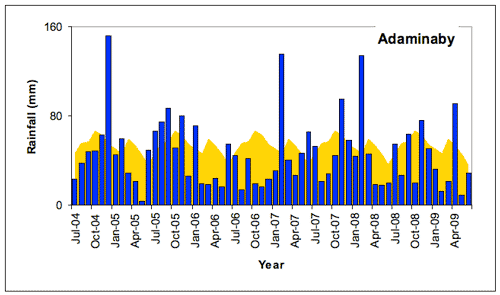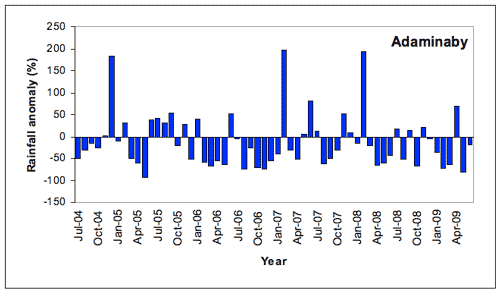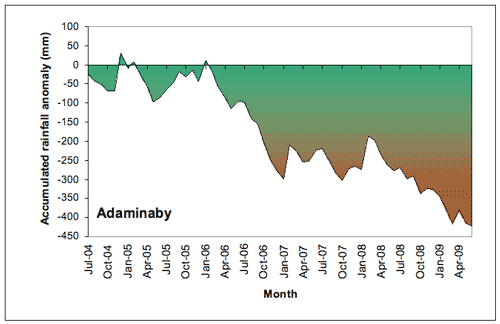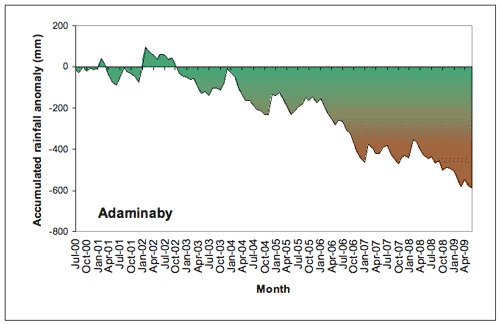Snowy River
Please note: Text or data highlighted in this colour represent an update to this indicator for the period 2008/09. All rainfall figures have been updated on this page.
Rainfall Analysis
The main rainfall observing site used in this analysis was Adaminaby Tourist Park (Bureau of Meteorology Station No. 071000), which has records commencing in 1886. Data from the nearest stations were used to calculate values for months with missing data at this site, although the distance to these stations, in excess of 20 km, means that these data can only be considered indicative (see Appendix 2 for further information).
Note that in the following analyses rainfall totals for individual months or years (where the year is defined as the 12 months from July to June) are compared to the long-term average (or climatology) from 1961-1990. A 30-year period is used to calculate climatological averages to conform with World Meteorological Organisation practice; this takes into account year-to-year variations and less frequent events such as El Niño or La Niña. This particular 30-year period is used internationally as a standard climatological average period.
As shown in the table below, Adaminaby was drier than average in all five years in the period 2004/05-2008/09. The driest year was 2008/09, when rainfall was 22.8% below the long-term average at 488 mm for the year. The wettest year in the last four years was 2005/06, when rainfall was still 6.9% below average (588.5 mm for the 12 months July 2005-June 2006).
| Rainfall Statistics | Adaminaby | ||||
|---|---|---|---|---|---|
2004/5 |
2005/6 |
2006/7 |
2007/8 |
2008/9 |
|
| Annual Total* (mm) | 579.9 |
588.5 |
504.6 |
579.3 |
488.0 |
| Anomaly (mm) | -52.6 |
-43.9 |
-127.8 |
-53.1 |
-144.4 |
| Anomaly (%) | -8.3 |
-6.9 |
-20.2 |
-8.4 |
-22.8 |
| Mean (1961-1990) (mm) | 632.4 |
||||
*Note: annual totals were calculated for the 12 months July-June.
Monthly Rainfall, 2004-2009
A comparison of monthly rainfall totals with the long-term monthly average rainfall at Adaminaby (Figure 1) shows the recurrence of spells of several months of below-average rainfall during this time interspersed with short periods of above average rainfall, usually of only one month duration. The dry period during 2006 was associated with an El Niño while the above average rainfall between November 2007 and February 2008 was a result of a La Nina event as was the rainfall in November-December 2008.
 |
Of the 60 months in this period, around 39 months (65% of the record) appear to have recorded below-average rainfall at Adaminaby (Figure 2). The most prolonged dry spell began in March 2008 and extended to June 2009, during which there were only 4 months of above average rainfall. Other significant dry periods were autumn 2005, February 2006 to January 2007 and March 2007 to October 2007. The driest individual month was May 2005 with 3 mm (the long-term average for May is 45.2 mm). Average or above average rainfall were recorded between December 2004 and February 2005, May to November 2005, May to June 2007 and November 2007 to February 2008 while February 2007 was also exceptionally wet. The wettest month was December 2004 with 152 mm (long term average 53.8 mm) whilst February 2007 recorded 135.5 mm and February 2008 recorded 133 mm. This December total was the third highest December total on record since 1886 while the totals for February were the sixth and eighth highest totals respectively for February on record since 1887. All the extreme recordings over this period were actual measured values and not derived.
 |
The result of the generally dry conditions at Adaminaby during most of 2004-2009 (punctuated by some months with high rainfall) is reflected in the accumulated rainfall deficit (Figure 3). Accumulated monthly rainfall totals varied around the norm during 2004/5 with a rapid increase in the rainfall deficit during 2006. The deficit then flattened out during 2007/8 with the impact of individual wet months causing rapid changes from time to time but then increased during 2008/9. The rapid drop during 2006 reflects the dry conditions due to the impact of the El Nino event during 2006/7. The accumulated deficit for the five year period was around 423 mm (67% of the Jul-Jun average rainfall).
 |
The climatological context for rainfall at Adaminaby
The long-term perspective
As is typical of the region, Adaminaby has experienced large fluctuations in annual (July-June) rainfall, including several extended periods of above- or below-average rainfall since records began in 1887. In general, annual rainfall was lower and less variable early in the 20th century, followed by a period of greater variability until the late 1950s. Rainfall variability has been lower since about 1980 (Figure 4). The recent dry period is reflected in other parts of the long term record such as the early part of the 20th Century, the mid 1960’s and the late 1970’s to early 1980’s. To this point in time this recent dry period can only be considered as part of the long term variability in rainfall experienced in the region.
- Rainfall in the late 19th and early 20th century was generally below average (until about 1915), and then fluctuated above the long-term average until the sustained dry spell of the early 1960s.
- Several wetter-than-normal years around 1950 and 1960 produced a generally wetter period then; the same is true of the mid 1970s and late 1980s.
- A generally drier period around 1980 was followed by slightly above-average rainfall until the early 1990s. Since 1996 conditions have been generally drier than average with a continued dry period from 2002.
The wettest year (July-June) on record was 1955/6 (1197 mm); the driest year was 2002/3 (405 mm).
![Figure 4. Annual (July-June) rainfall at Adaminaby from 1887/8 to 2008/9 depicted as deviations from the long-term mean. A 5-year running mean is superimposed to highlight wetter and drier periods. [Deviations were calculated as the difference between the rainfall for each year and the mean for the period 1961-1990 (scale in mm).]](../images/snowyriver/rain04.gif) |
The longer-term pattern of accumulated rainfall (Figure 5) shows rainfall varying around the average until 2002, when below-average rainfall led to the start of an accumulating rainfall deficit. Heavy rainfall temporarily eased the deficit in late 2003 before increasing during 2004. The deficit flattened out during 2005 before increasing rapidly again in 2006 and flattening out during 2007/8 before increasing again during 2008. The rapid increase in the rainfall deficits in 2002 and 2006 reflects the impacts of the two El Nino years of 2002-3 and 2006-7. During the whole period there were around 73 months (68%) of rainfall deficits with the total accumulated deficit for the period being around 588.5 mm (90% of the average Jul-Jun rainfall).
 |
About the data
